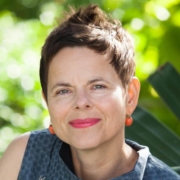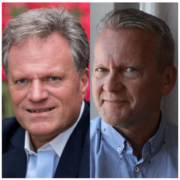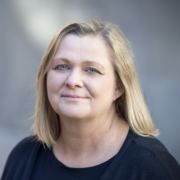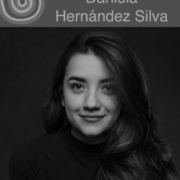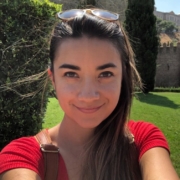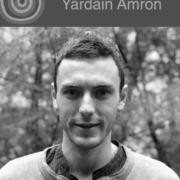Michael Rumbelow
Behind the Scenes: Playing with Blocks
Today Michael Rumbelow joins me to talk about his FreshEd Flux episode. I recommend you listen to that episode before you continue with this one. In our conversation today, we talk about maths education and the power of block play. We even listen to a few clips of Michael’s Flux episode to dissect the subtext and sounds. Michael Rumbelow is a PhD student at the University of Bristol.
Citation: Rumbelow, Michael, interview with Will Brehm, FreshEd, 304, podcast audio, December 5, 2022. https://freshedpodcast.com/rumbelow/
Will Brehm 0:21
Michael Rumbelow, welcome to FreshEd.
Michael Rumbelow 1:21
Thanks, Will.
Will Brehm 1:22
Congratulations on your Flux episode. It’s like this sonic journey going all over the world and the universe, listening to the sounds and your voice and these multiple stories. It was really quite the journey, I felt, as a listener. So, congratulations on it. I guess I want to start by just asking, what was this fellowship like for you? What was it like to put together this episode over the last year?
Michael Rumbelow 1:47
It’s been a wonderful experience, really. I didn’t really know what to expect but it’s just turned out to be this sort of creative journey really, and sort of another dimension to everyday research is just making these sonic representations of things. And just to have the support and the expertise that you guys bring in, and especially the creative support. It’s been fantastic.
Will Brehm 2:13
It really was quite a collaborative process with you, and Jo, and Brett and myself. And it was a journey. I sort of am surprised by the outcome in a way. You know, it is so incredibly, beautifully put together sonically, but it’s also quite deep. There’s a lot of meaning behind what you created. Did you ever think that you would be able to produce something like this? I mean, it was quite incredible. Like, did you have experience with audio before coming to this fellowship?
Michael Rumbelow 2:39
A little bit. I always loved audio as a medium. I mean, I tend to listen to radio rather than – I don’t have Netflix or anything like that and tend to listen to radio music. And even as I started doing my PGCE (Postgraduate Certificate in Education) teacher training, I remember my project was to use audio to convey mathematical concepts. So, I’ve sort of had this interest and it seemed just this opportunity to explore that – the audit audio side of things. And a couple of colleagues were looking at doing creative things, research wise – creative methodologies with poetry and multimedia – so that sort of piqued my curiosity as well. And then when I saw the ad, it just seemed like a great opportunity to have a go at that.
Will Brehm 3:24
I love it! It’s so interesting to realize that there’s so many people in the academic space looking for alternative outlets to express their ideas other than the written form. I’m so thrilled that we were able to provide you some space to do that and sort of explore your ideas sonically. What was most challenging for you?
Michael Rumbelow 3:42
I think probably the most challenging was finding a format and never having really done it before. And also, just having this creative freedom really. So, it ended up very different from what it started out as. It started really as a very sort of abstract idea of blocks of sound without any real narrative. And then over time, it kind of evolved into this physical location around the Tavistock Square, and a sort of a journey around that square. And I could never really have predicted that. It’s just little things fell into place like the Virginia Woolf statue, and a kindergarten, and the various characters mentioned in the episode, who happened to have been on that square at some point in history. But yeah, really, that was the challenging thing. I think, over time, it’s writing the format. And then the technical side was a learning curve, I would say. So, I wasn’t familiar with a lot of the software and equipment. So, I mean, it was fun learning, but it was a quite technical steep learning curve, I think. Yeah. It’s fair to say, but worthwhile.
Will Brehm 4:45
Yeah, I would imagine. Excellent. I’m really happy. I mean, so that’s quite interesting that the narrative sort of came second from a lot of the ideas of playing with sound and blocks and that you’re saying that with Tavistock Square, some of the stories that you tell in the episode of the different characters on Tavistock Square, you sort of learned of those stories in the process of researching this episode.
Michael Rumbelow 5:06
Yeah, very much so. I mean, I hadn’t really known only about Tavistock Square, but then had vaguely read and researching the Ronges’ first kindergarten. They’ve mentioned their address in one of their books from the time and I’d been curious where that was. So, one night it was during the lockdown, I just dropped someone off at a hospital nearby and it was deserted. So, I just had some time to film. So, I went to look for this first kindergarten and ended up sort of peering into this window. It looked like an empty at the time hotel, trying to look for this painting of the solar system on the ceiling, which is mentioned in this book from the kindergarten. Just something to do really, but I couldn’t find it. No, no. It turned out I was in the completely the wrong place. All the numbering has changed over the years and things. And then I passed this pub called The Woolf and Whistle which was also closed at the time. But it just piqued my interest and connection with Virginia Woolf and yeah, just one thing sort of led to another just sort of grew out of that really. The connection with Tavistock Square and yeah, really, Virginia Woolf particularly sort of seemed to be this thread that sort of led me down that that route, really.
Will Brehm 6:19
You know, historically, it’s just quite amazing. All the people that lived on Tavistock Square and all the people that ended up having sort of international fame and, you know, these huge individuals all living at different times and sometimes overlapping times in Tavistock Square, it’s quite incredible.
Michael Rumbelow 6:36
Yeah, I know! I mean, I wonder how that might be true of other places. But if you do walk around Tavistock, there’s a lot of kind of blue plaques in that area of London. It just seems like it’s changed a lot over the years. In the days when the Ronges’ were there, it was actually quite – in Victorian times – I think, at times, it was not such an affluent part of town really. There were people coming from Germany or refugees who were living there. And just interesting sort of found over the history of how it has changed. And yeah, there’s I think, Vladimir Lenin, and Jerome K. Jerome. All these plaques of various people and lots who aren’t celebrated with the plaques as well.
Will Brehm 7:17
Yeah, exactly. I mean, it’s quite incredible, really. And how it maps on to your initial interest in ideas around blocks and blocks of sound. So, Michael, blocks were so important for this whole process and of course, in the final product that you created. You hear blocks everywhere. Did you play with blocks when you were a child? I’ve always been fascinated to try and understand where your interest in blocks derived from?
Michael Rumbelow 7:43
Yeah, I mean, I don’t feel like I was much more than maybe other kids. But I did love Lego as a child. And recently, my sister found a box of Cuisenaire rods that we had as children. She didn’t know what they were actually. But of course, I mean, I recognized them. And they still sort of got a certain feel, and texture and smell that I remember from those times. And then, yeah, there is one picture of me, I think, as a child with this helicopter made of LEGO that I was obviously very proud of at the time. So, that was obviously an interest there. And then I think when I went to do my PGCE and set to be a secondary maths teacher at the Institute of Education (IOE). I mean, the IoE is where Gattegno really championed these Cuisenaire rods, but at the time, they’d remember they’ve kind of fallen out of fashion a bit, I think, you know, I remember someone saying, “oh, you know, they don’t use these days, because people think that children associate the number four with the color green”, and it was not seen as so relevant in those days. But then, In England, there was a national numeracy strategy in the early 2000’s, which had pros and cons. But there was some materials that came out with that. They were nice in that they had all these visual images of these manipulatives. They call them like blocks and things like that, which are used. And then I was working on online games in my job. And we basically based the games on these manipulatives, which were a number line as counters, and there were these blocks. So, we had a big tub of these blocks in the office. And I remember just sometimes coming back to the desk, and I discovered these little sorts of little mini structures that people had just made on the desk. And sometimes when I was sitting with people, they would just start playing with these blocks and leave these little sorts of sculptures on the desk. And then after a while I notice people were putting their names, making their names out of these blocks and putting them on the top of their desks so that after a while the office had all the people’s names. And this was all sort of spontaneous. It wasn’t encouraged by me at all, but it did make me think there’s something in block play for all ages, really, you know. People sort of naturally kind of tend to build things. So, that was what really got me interested, I think
Will Brehm 9:51
And are you studying something related to this in your PhD?
Michael Rumbelow 9:55
Yes. I am studying block play. I’m looking to study what happens when children play with blocks in preschool, or here, it’s called early years and foundation stage. And then that seems to change as they go into primary school where there’s a lot of focus nowadays on using blocks for modeling of mathematical arithmetic, and the government approved textbook says they’re very common. Now these blocks. So, I’m looking at what is happening with the block play across that transition. And in particular, the relationship with attachment theory and potential sort of projection of triadic and dyadic relationships onto blocks and play.
Will Brehm 10:32
What’s amazing is that what you’re exploring in your PhD in many ways, there’s elements of it in the episode that you have created because you can sort of hear the children playing with blocks. We hear Melanie Klein talk about projection, we hear issues around the triadic and dyadic relationships. In that latter one, what is so significant when it comes to blocks and children playing? When it comes to sort of twos and threes?
Michael Rumbelow 10:55
Yeah. With the twos and threes, I think my first encounter that was sort of focused on twos and threes was really from coming somewhere by Brian Butterworth who has studied something called number sense, in early children. And the idea that before you can count, you can tell how many things there are up to three or four. And there’s some good research where you can see these graphs of how long it takes people to count things. But 2, 3, 4 things -it’s called subitizing. You can just tell how many there are at a glance. And that got me interested in the psychology of what was happening, not just cognitively but psychologically with twos and threes. And I read a bit of Jung’s, Man and His Symbols. At the end, it sort of points to young being very interested in the basics of maths from a psychological point of view, which got me interested in the psychological side. And then my supervisor put me on to Abraham Seidenberg who has done some work on odd and even numbers and the ritual roots of those and then looking even at the sort of ancient Greek mathematics. Plato seems to have been very influenced by Pythagorean thought, which is really all about two’s and three’s, a lot of it. And so yeah, that was where a lot of that interest came from. And then looking at Klein and coming across some of her thoughts and Wilfred Bion as well. And they attached this psychological significance to splitting and then to the third other, in psychological, early formative relationships. So, yeah, that was really the sort of rather convoluted kind of journey. But once you start focusing on two and three, I think it has all these connections to lots of different fields, I think.
Will Brehm 12:39
Yeah. It’s quite amazing to hear you make all these different connections just by starting with how children play with blocks, and then how it sort of informed so many big theorists and academics that many different fields use even to this day. And what was so interesting about your episode is that you then were able to sort of tell this story through sounds in many ways, or the sounds gave us insights into some of these ideas. What I’d like to do is actually play a few clips of your episode, and then just have you talk through some of the subtext of these sounds that you were working with. The first one, you had this sound that was, I think, created by something called a whirly tool. So, I’m going to play it for us. And then if you could just tell us what that sound means to you. What’s the subtext behind this sound?
Michael Rumbelow 13:33
*Haunting sound plays with Michael’s voice over*. A lot of the roots of mathematics are in nature. Geometry literally, earth measuring. Geo -earth, and metri -meter measure from the same root word as mense month, moon as in commensurate. The full moon, quarter moon, new moon, Earth, Moon and Sun. Two bodies orbiting in space in a pool of the third. The three-body problem. Or is it a problem?
Will Brehm 13:33
Okay, Michael. So, take us through that.
Michael Rumbelow 13:33
Yeah, I call it a “whirly tube”, but it seems to have these different names. You see them sometimes sold on the beach in England, and they’re basically sort of plastic tube that you whirl around, and it makes that sound. And I think, from a mathematical point of view, it’s playing very simple harmonics. And as I understand it, it’s sort of vibrating at half the length of the tube and then a third of the length as you speed up the spinning. So, it was interesting from that point of view of it sort of counting up in these vibrations, you know. Double the vibration, triple the vibration as you spin it, and it’s got this quite haunting quality I think of this whistling wind as well. So, that was a real appeal. And it’s kind of got this – for me anyways – this association with the beach and the waves which seem to fit with several things, including Virginia Woolf. And some later over the three-body problem just because of the switching up, I think from two to three and the three-body problem being in Newtonian mathematics is more or less solved. This mathematical problem of how two bodies orbits each other, like the Earth and the Sun. But when you add a third body, this is still unsolved in mathematics. I mean, there’s lots of good approximations but that’s actually not been completely solved as to where these bodies are, and how they spin around each other. So, that was the reasoning for layering those sounds.
Will Brehm 15:43
I loved it. You know, there’s actually a video of you spinning that whirly tube in the IoE. And I think we posted it on Twitter. So, I would encourage listeners to go and look at it. But I remember you coming to the IoE, when we met in person to do some recording, and you had this little whirly tube in your bag of tricks as I started calling it, because you always had these like different toys and things to experiment with, and more or less to play with. And one of the things I realized is that making this episode with you was one big process of play. Like we just played with sound, you played with ideas, you played with editing, and you sort of pulled it together in these really sort of complex ways. But also, really enjoyable ways. So, it was just so amazing, in a way.
Michael Rumbelow 16:30
Yeah, it was. I did enjoy wandering around with you guys as well really sort of opened my eyes to a lot of the sounds that can be recorded and then played within the edit as well. Like the sort of crunching of the feet on gravel, and bird noises and just yeah, lots of things – railings, you know, tapping them as we went around. And, yeah, it was a lot of fun. And that was part of the idea really to sort of explore this kind of kindergarten experience of the recording as well as in the content.
Will Brehm 17:01
So, a lot of the sounds you ended up recording yourself versus sounds that you just found online and used or a little bit of both.
Michael Rumbelow 17:08
Yeah, I mean, I think the first one was – I literally just got the fellowship and hadn’t really done any recording and then having this recorder and realizing that the winter solstice was just coming up in well, 21st of December. And there was a celebration in Stanton Drew, which is just outside Bristol, the Stone Circle there. And going down there at dawn with this recorder and sort of standing outside the circle just capturing some of the sounds and then just hearing all these dawn chorus of the birds and I remember going to – there is a churchyard there and just the clang of the gate of the church are just sort of standing there clanging this gate to get this great sort of clanging noise. Yeah. So, apologies to the neighbors, if they were there at the time, we clanged the date at dawn. But the sound qualities were just lovely at that time of day out in the countryside. That really opened my eyes to it. And then yes, playing with all the online sounds. I’ve just found it a lot of fun just playing with the different layering of – you can get a lot of great free sound effects now online.
Will Brehm 18:10
It’s quite amazing to think about all the different layers that you’ve put together. Some that you recorded, some that you found online, some was the narration that you created. But you did create these sorts of worlds and feelings and emotions all through sound. I want to play another clip, and have you sort of talk through it because this one uses sound in such a beautiful way and I think has a deeper subtext as well. So, let’s listen to this one.
Michael Rumbelow 18:41
Here, there is still the original townhouses with that classical Georgian architecture. Based on musical harmonies, Goethe called architecture frozen music, and music liquid architecture. So, for instance, if you look at the windows, they’re all the same width. On the top floor their square, lower down they are double heights. The music double the pitch is the same note an octave higher, and below that they’re triple high. This ratio of two to three is one of the most common harmonies in music. The ancient Greeks believed that two was the female principal, and three the male, and that the harmonies of these vibrations resonated with their gods, the planets, and the heavens. If you want to stick around the double length window, tapping each corner, you’ll get a double length beat, followed by a single beat along the short side. The threeness and the twoness like the rhythm of a waltz, or a heartbeat. Like the rhythm of the corners walking around Tavistock Square, or dancing around it. Are the so-called irrational nominees that didn’t fit this female-male, two-three ratios and the side of the Square with its diagonal cause the ancient Greek philosophers’ problems.
Will Brehm 20:20
Okay, Michael, walk us through that. I mean, there’s so much there.
Michael Rumbelow 20:24
Yeah. I think the original thought behind that was that if you look at the maths curriculum over 1,000 years – probably in Western Europe, at least from the ancient Greek traditions, right up to sort of medieval times – music was definitely part of the maths curriculum. And the four strands of the maths curriculum were geometry, which was number in space, music, which was number in time, and astrology, which was number in time and space, which was related to the music of the spheres and finding these harmonies that resonated with the cosmos really right back from Platonic philosophy. And so, one of the main instruments in those days, I think, for learning maths was a musical string; just monochord, which you could divide into these ratios. And they really attached a lot of importance to this philosophically and seemed to influence a lot of the architecture and the principles of the architecture as well. So, when classical architecture was revived in Europe, and in the 17th and 18th centuries, seem to translate into all this architecture in London. And so, it’s still there really this connection with the musical harmonies, which I was trying to bring out.
Will Brehm 20:24
And the Waltz itself, the Blue Danube, I mean, when I hear it, I think of 2001, the Space Odyssey, Stanley Kubrick’s movie. I mean, was that intentional?
Michael Rumbelow 21:26
Yes. I mean, originally, I was trying to find ways of referencing that a little bit in the episode. Really because of the monolith and the idea of this block that is sort of mysterious, and also has all these sorts of deeper meanings projected onto it. So, yeah, that was just sort of nod towards that really, yeah.
Will Brehm 22:29
And when you talk all about the different windows of the Georgian architecture in Tavistock Square, personally now, ever since I’ve listened to your episode, I can’t walk around London and not look at Georgian architecture and think about all the ratios as you’ve described them in your episode. Like that’s now how I see the world.
Michael Rumbelow 22:49
Oh, that’s great. A sort of similar thing happened to me, really. I think I went to an exhibition about Palladio and then after that everything seemed to be twos and threes.
Will Brehm 22:59
I think you have a line in the episode, like, you see blocks everywhere. And now listening to your episode, I sort of am seeing blocks everywhere I go in the world.
Michael Rumbelow 23:08
Yeah. I sympathize. And then also, it sort of highlights where the ratios don’t work. Especially more recently, you know, the postmodern sort of has broken up those harmonies a little bit, and alongside all this sort of directions in Western music as well, with the classical music anyway. And lots of other traditions are sort of disrupting that sort of neat ratios, I think. So, at the end that dissonant harmony was just a sort of allusion to that really.
Will Brehm 23:40
And it also connected to even the design of Tavistock Square, as you clearly say, is not actually a square, but sort of has this diagonal side to it as well.
Michael Rumbelow 23:50
So, yes, the diagonal of a square is, what they call in maths, an irrational number. So, you can’t express it as a ratio of two whole numbers. And the diagonal of a cube. So, from one corner of a cube to its opposite corner is, again, the square root of three, which is another irrational number.
Will Brehm 24:12
You know, I really love what you’ve done in this episode, where you take some of these mathematical ideas, and you show how they exist in space in reality – so such as Tavistock Square – but you also make these connections to music, to Greek philosophy, to children playing with blocks. And so, it’s just this unbelievably deep engagement with sound and the layers of sound that you’ve created that I think need a lot of unpacking, in a way. And it’s why in your episode, you’ve actually added all these footnotes to your episode. So, if you go online, and look at your episode, you’ll find all these footnotes that you’ve created. Can you talk a little bit maybe just about some of these footnotes and what the purpose behind them was?
Michael Rumbelow 24:55
First, just to capture some of the stories behind the little references that may not be obvious listening to the episode straightaway, or for people that might be interested. And there was lots of sorts of detours, you know. So, lots of things that didn’t make it into the episode. So, it was a way really of capturing some of those. Yeah, I think some of these elements may seem a little bit disparate. I mean, there’s a vague thread of them being linked to the walking around the square. And I think the footnotes was a way of sort of adding other threads that that can tie these various elements together a little bit.
Will Brehm 25:35
Okay, I have one final clip from your episode to play that I’d love to hear some of that subtext and how you sort of threaded this all together and connected it to this idea of mathematics and blocks. So, here we go:
Michael Rumbelow 25:49
Where they opened the first kindergartens there, then the movement spread around the world. *Youth singing*
Will Brehm 26:20
Okay. Can you explain what was going on in that clip?
Michael Rumbelow 26:24
Yeah, I think I just came across on YouTube, this Viennese boys choir recording of that, sea shanty, which had gone viral over lockdown. And the children singing, which is a big part of kindergarten, had the harmonies and also had this sort of viral quality, the way it spread around the world. And the way that seemed to reflect a bit the way kindergarten is quite remarkably, I think, spread around the world. And following these a lot of the time, these colonial sort of roots of either the ships, and the sugar, and the tea, and the rum that I mentioned. And also, it’s about whaling, if you listen to the whole shanty. And it comes traditionally from a whaling cruise around New Zealand, which seemed to resonate with the move of Cuisenaire rods in the silent way around the world to New Zealand as well. And also during the episode I became more interested in Deleuze and Guattari, two French philosophers, and their idea of the refrain, and they talk a lot – if you ever read the book 1000 Plateaus – about, I think, on the first page is this picture of a score by Messiaen and they talk about his interest in Birdsong, and how that was whether the seagulls were sort of coming in a little bit anyway. But this idea of a refrain that can start in one place and then become something else somewhere else.
Will Brehm 28:01
It’s so deep, right? There’s so many layers here and so much meaning behind this sound. And yet, it sounds so beautiful. The Viennese boys’ choir, I guess also connects to Melanie Klein, in a way, who also lived in Vienna. So many interconnections. It’s quite incredible to hear this final product and realize all of these interconnections. But I guess going back to some of the main points about children’s block play and the sort of pedagogy of learning through block play. Having put together this episode, and all the different sounds that are used in it, what does it say about learning to you? What does it say about how, through this process of creative creation? What does it say about learning and pedagogy to you?
Michael Rumbelow 28:46
Yeah. I think I’ve become more into sort of reading Froebel, particularly I think about his pedagogy. And one of the things I find, if you go back to Froebel – if you read his book, say, The Education of Man is sort of a seminal book about education. And it’s, and it’s really quite a challenging read. I mean, it’s quite mystical, a lot of it. And he talks a lot about crystals and these natural world elements, and he seems to relate nature and crystals and trees and things like that, with these relationships within families. Sort of like the idea of connecting with mother nature as almost like a familial relationship. And particularly for pedagogy, I find that really interesting, especially in the age group, I’m looking at, like the younger age group. How we bring these anxieties and hopes and desires from birth really, and how they translate into pedagogy. I think often the pressure seems to be sort of to push curricula earlier and earlier, whereas I think there is a lot to be said for expanding kindergarten sort of philosophies up into the primary and secondary age groups. So, I think that’s been the thing I’ve really taken away, more confidence in kindergarten pedagogy and philosophy.
Will Brehm 30:11
Now that you’ve sort of finished this Flux fellowship, and you created this really beautiful episode, do you think you’re going to approach your PhD research differently in any way?
Michael Rumbelow 30:23
Yes, I think so. I mean, I think it’s sort of encouraged me to look more at creative methodology, certainly. So, I’ve been exploring ways I could possibly use block structures in authoring the PhD somehow. I’m not sure yet how, whether it’s through a sort of block constructed sort of elements of the PhD, or through the structure of the actual text somehow in blocks. But yes, it’s definitely sort of opened my ears and eyes to lots of new possibilities in research and studying in a PhD definitely and playing with blocks with the kids. I’m looking forward to that sort of thing. Observing that and seeing what they come up with as well.
Will Brehm 31:10
Well, Michael Rumbelow, thank you so much for joining. I really look forward to actually reading your dissertation when it’s done. I feel like you’re going to put together something quite different and unique from say, the “normal” dissertation that a PhD student might produce. So, congratulations on your episode. Thank you so much for sort of “playing” over the last year. It’s really been a pleasure on my end, and best of luck on your PhD journey.
Michael Rumbelow 31:34
Oh, thanks so much, Will. Yeah, it’s been an absolute pleasure.
Want to help translate this show? Please contact info@freshedpodcast.com
Related Guest Project/Publications
Using AI block play recognition to endorse children’s mathematical re-worldings
Transitional objects and early algebraic thinking
Designing Cuisinaire rod ‘object lessons’ to bring music back in harmony with mathematics
One, You, She: Object relations as grounding metaphors for learning mathematics
Mentioned Resources
A practical guide to the English Kinder-garten – Ronge
Selected works of Virginia Woolf
Three men in a Boat – Jerome K. Jerome
A teacher’s introduction to the Cuisenaire-Gattegno method of teaching arithmetic
A head for figures – Brian Butterworth
A new decision method for elementary algebra – Abraham Seidenberg
On the development of mental functioning – Melanie Klein
Pythagorean mathematics and music
The psycho-analytic study of thinking – Wilfred Bion
A thousand plateaus: Capitalism and schizophrenia – Deleuze and Guattari
Related Resources
Learning engineering through block play
Engaging Algebra early through manipulatives: Reappraising Cuisinaire-Gattegno rods
The development of arithmetical abilities – Brian Butterworth
Have any useful resources related to this show? Please send them to info@freshedpodcast.com

